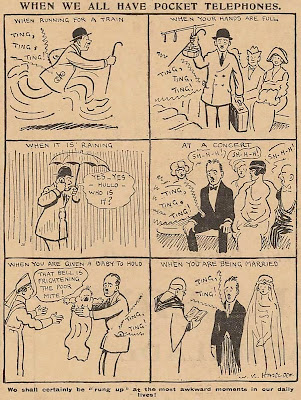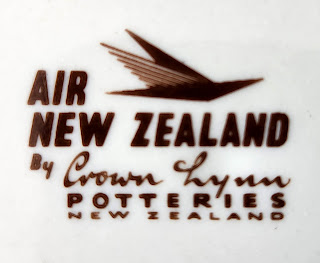 |
| A Satirical Cartoon lampooning the use of "Pocket Telephones", 1919 |
 |
| "Development of Wireless Telegraphy", 1906 |
In early December 1906, the English "Punch" magazine, being a satirical publication renowned for lampooning both people and ideas, published a cartoon as part of their "Forecasts for 1907" series ridiculing the idea of "mobile" communication. Drawn by Lewis Baumer, this cartoon portrays a man and a woman seated in London's Hyde Park, both individually communicating using portable wireless telegraphy equipment. Note the antenna on their heads. The woman is receiving an amatory [expressive love] message and the man is receiving racing results. Both machines are merely small boxes but are capable of printing wireless messages on tape. As Telegraphy was then the primary and fastest means of remotely sending short messages it is perhaps not unsurprising that Baumer envisaged a portable but wireless version of the Telegraph. As LED type screens did not then exist it would naturally be assumed that messages would need to be printed out and in fact such "telegraph" type techonology with messages printed onto a paper strip had already been invented. But for us today, this cartoon would be the closest one could then have possibly come to the idea of "mobile" text messaging using a portable device.
 |
| A "Marconi" Wireless Telegraph Receiver manufactured from 1906 to 1912 |
Although wholly in jest, the technology allowing oral messages to actually be sent and received via wireless had also already been invented. Guglielmo Marconi had demonstrated his wireless transmission device to the British Government as early as 1896 going on to make a successful transmission across the English Channel in 1899. So while such technology was not in everyday use it was at least well known. It is interesting that the cartoonist only envisaged that personal portable "wireless" communication would, in the future, be via the medium of printed messages and only receiving rather than transmitting. I very much doubt we would all wish to carry portable 'teleprinters'.
In 1908, Professor Albert Jahnke, along with the rather grandiosely named "Oakland Transcontinental Aerial Telephone and Power Company", claimed to have invented the first "wireless telephone", and duly filed a patent application. Incredulously, such was the disbelief that such technology would even be possible that the company were initially charged with fraud. Although all charges were dropped the technology was evidently still ahead of its time, required further development, or was not then commercially viable, and nothing more appears to have come of it.
 |
| Francis J. McCarty testing his radiotelephone Transmitter, San Francisco, Oct 1905 |
But curiously, I note another company, the "McCarty Wireless Telephone Company of Arizona" publicly advertising in April 1908 that they had no connection with the Oakland Transcontinental Company currently facing fraud charges and with the "arrest of the promoters". The McCarty company note that they are still;
"...pursuing with its experiments to determine whether there is any practical or commercial value in wireless telephony... That spoken language can be transmitted through the medium of the atmosphere, and without the use of any other connection, is an established fact, but whether spoken words can be transmitted to such a distance as to make it a practical utility, is the question to be determined. It is this question that the McCarty Company is now engaged in trying to solve..."
With the unfortunate death of the inventor and prime promoter, Francis McCarty, having occurred in May 1906, two of the McCarty Company's investors, bankers William and Tyler Henshaw, had contracted another then well-known inventor, Cyril F. Elwell, to review the potential worth of McCarty's patents. Elwell eventually concluded that the system's apparatus was incapable of ever being refined enough to become an effective radiotelephone system. The Oakland Transcontinental Company's work probably met a similar fate, no doubt not helped by the adverse publicity which would have scared off further investors, even if all charges had been dropped. While the technological hurdles yet to overcome were complex, slow progress would continue to be made, the potential this technology offering to aid communications being evident to all.Now fast forward to 1917. The first serious contender at a "mobile" telephone appears to have been a patent filed for a "pocket-size folding telephone with a very thin carbon microphone" by Finnish Inventor, Eric Tigerstedt. But without seeing a photo of the design, his invention actually sounds more like the miniaturized "flip phone" of the 1990's, hardly the large "brick" 'Motorola' portable phone that would became commercially available in the 1980's. No further information about this device can be found.
 |
| "When We All Have Pocket Telephones" - A cartoon drawn by W.K. Haselden published in "The Daily Mirror" on the 5th March 1919 |
Development of portable "wireless telephony technology" continued apace and it was only the following year in 1918 that Imperial Germany tested telephone technology on military trains. It should come as no surprise that the military had quickly forseeen the possibilities inherent in this new technology.
In 1924, "Deutsche Reichbahn", the German National Railways under the Weimar Republic, began a public trial of wireless telephony on trains running between between Berlin and Hamburg. Evidently being successful, wireless telephony would then be introduced on other routes, the German company of "Zugtelephonie AG" [literally meaning 'train telephony') being founded in 1925 to manufacture and supply equipment for both the German National Railways and German Mail services.
 |
| Mobile Telephone usage as envisaged by German Artist Karl Arnold, 1926 |
Little wonder that in 1926 the Munich based German satirical weekly magazine, "Simplicissimus", published a drawing by caricaturist Karl Arnold entitled "Berlin Wireless Telephony" showing people in the street using and carrying "mobile telephones". The text basically reads; "Presently at corner of Friedichstraße - Behrenstraße [Berlin].... good - wonderful - done - coming straight away". Prophetically, this cartoon published 98 years ago mimics the self same situation we can find ourselves in today and begs the question, has such technology always enriched our lives or have we become enslaved to it?
 |
| A fanciful 1957 comic strip from "UT Magazine" portraying a "Tonton" (Uncle) at the Moscow Festival calling his family in Paris on a "mobile" phone |
Unsurprisingly, throughout the 1950's research into and development of a workable cellular "mobile phone" also took place in Communist Russia, specifically by Soviet Engineer and Inventor, Leonid Kuprayanovich. Shown below (at left) is the Inventor with his LK-2 "Radiofon" device weighing 3kg and dating from 1958. And at right his LK-3 device dating from 1961 now weighing only 70gm and which could be held in the palm of your hand. But note the now seemingly archaic "dial" on both versions so "Blackberry" phone type push button technology still had some way to go.
 |
| Leonid Kuprayanovich with his 1958 LK-2 "Radiofon" (at left) and his 1961 LK-3 palm-held version (at right) |
 |
| The "Mansfield News Journal" of 18th April 1963 published an article accurately predicting the widespread use of "Pocket" telephones in the future. |
In April 1963 the "Mansfield News Journal" of Ohio USA, published not only an article accurately predicting the features of the modern "flip" phone but also a photograph of what this may look like. The article stressed however that; "The phone is still in the development stage and far in the future" and that; "It's a laboratory development". Despite this, the various features available on moden day portable mobile phones were predicted with quite startling accuracy although I would perceive that the article would be need to be worded differently today when it comes to assumed household roles!;
"...it's workable, allowing the carrier to make and answer call wherever he may be. Other telephones of the future includes a kitchen loud speaking telephone, and a visual image telephone. The kitchen instrument can be used as a regular telephone, a loudspeaking phone if the housewife happens to be busy preparing a meal, or as an intercom station for the home. The visual image telephone allows the parties to converse by way of a microphone and loud speaker while a miniature television camera transmits the image. The "TV phone" also will have a writer signature transmission system and a conversation tape recorder."
 |
| The first commercially available Mobile Phone, 1983 - The Motorola "DynaTAC 8000X with permanently affixed aerial. |
It was not until 1973 that "Motorola" demonstrated their new cellular phone which weighed a whopping 2 kilograms (4.4 lbs). They had in fact already been designing "mobile" phones for cars but these were decidedly power hungry and anything but mobile in their own right. The first commercial cellular network, as we would know it today, was in fact only launched in Japan in 1979.
Finally, "Motorola" launched the first commercially available mobile telephone in 1983, being the "DynaTAC 8000X". A full charge would take 10 hours with only 30 minutes of talk time. The cost of the phone was also prohibitive, let alone the ongoing subscription to connect to a cellular network. This was initially restricted to main centres and even then with rather patchy reception. In early 1994 I recall a decidedly pushy and obnoxious Real Estate agent standing right in front of me dropping her "brick" mobile phone onto a concrete pathway and I will always remember the look of horror and then dread on her face as she picked it up wondering if her expensive toy was broken. I did rather think at the time that this was a good example of karma! But if you still have an early old "brick" phone it could now be worth a dollar or two.
 |
| A thick & chunky but lightweight "Pantech" South Korean made analogue Flip-Phone manufactured c. early 2000's. [From my own collection] |
Post 1983, technology has continued to progress in leaps and bounds, the phones themselves having shrunk, many more options and applications (apps) have transformed usability, while performance and battery life have markedly increased. And now even the screen on the latest "flip" phone folds. But looking back to how cartoonists 100 years ago futuristically viewed "mobile" telephones into the next century, it leaves me wondering what advances we shall make over the next century - and whether this will truly benefit us or in fact hinder us? Most likely a good measure of both.
All Rights Reserved
Sources :
- Images (unless otherwise stated) from Public Domain
- Wikipedia
- Various Internet resources
- "The Guardian" newspaper
- "Отечественные Мобильники 50-Х"






















